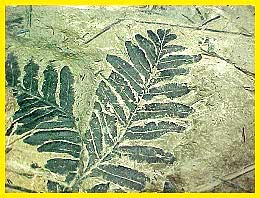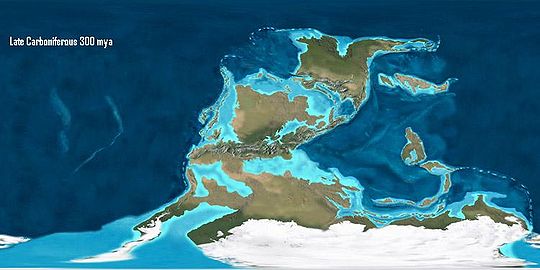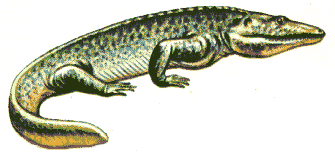
Alethopteris from the Pennsylvanian of West Virginia, USA. From Indiana9 Fossils (which has a whole page of Alethopteris images).
| Pennsylvanian Epoch | ||
| Paleozoic: Carboniferous Period |
Pennsylvanian |
| Mississippian | Devonian | Carboniferous | ||
| Cisuralian | Permian | Bashkirian | Timescale |
 The Pennsylvanian was the time of the great 'Coal Swamp Forests' which dominated the equatorial regions of the planet. Typical Carboniferous forest, late Pennsylvanian. (screenshot from Prehistoric Park TV series)
The Pennsylvanian was the time of the great 'Coal Swamp Forests' which dominated the equatorial regions of the planet. Typical Carboniferous forest, late Pennsylvanian. (screenshot from Prehistoric Park TV series)

Lasting some 33 million or so years, the Late Carboniferous or Pennsylvanian age was the high point of stem tetrapod evolution, especially during the Bashkirian and Moscovian epochs. During this time the first reptiles and synapsids evolved and quickly diversified. By the end of the period these new forms, especially the synapsids, had supplanted the stem tetrapods as the dominant life form on land.

During the late Carboniferous period Laurussia and Siberia collide to form Laurasia; meanwhile Gondwana comes up from the south. The resulting Appalachian, Ouachita, Marathon, Ural, Variscan, and Hercynian orogenies formed some of the largest mountains of all time. As a result of the collision of Gondwana and Laurasia the supercontinent of Pangea comes into being.
 Alethopteris from the Pennsylvanian of West Virginia, USA. From Indiana9 Fossils (which has a whole page of Alethopteris images). |
On land, great forest swamps covered extensive equatorial areas. These forests consisted of diverse plants including tree ferns, which grew 15 meters in height, Calmites, a giant version of the modern "horsetail" plant, lycopods (e.g. Lepidodendron, which attained a height of 30 metres), the extinct group of plants called "seed ferns" see illustration at left), and primitive Conifer-like plants (Cordaites) that reached 40 meters in height |
The extensive burial of biologically-produced carbon led to a buildup of surplus oxygen in the atmosphere; estimates place the peak oxygen content as high as 35%, compared to 21% today. This oxygen level resulted in insect and amphibian gigantism--creatures whose size is constrained by respiratory systems that are limited in their ability to diffuse oxygen. In this  In the moist oxygen rich atmosphere flying insects were abundant, and some attained huge size, such as Meganeura, with a wing span of 70 centimetres
In the moist oxygen rich atmosphere flying insects were abundant, and some attained huge size, such as Meganeura, with a wing span of 70 centimetres

Tetrapods were abundant, especially the "labyrinthodonts," so called because of the complex (labyrinthine) pattern of folded enamel in their teeth. They filled every available ecological niche, from fully aquatic eel-like forms, to large semiaquatic crocodile like animals and small forms like modern day newts and salamanders, to terrestrial types similar to reptiles. Some types (the Aïstopoda) lost their legs altogether, superficially resembling snakes.
 The earliest Reptiles also evolved at this time, such as Hylonomus (left) but remained relatively insignificant until the end of the period. Reptiles have a big advantage over stem tetrapods in that they do not have to return to water to breed; they can lay their eggs on dry land. So it is likely that with the appearance of reptiles the tetrapods* (land animals) were able to colonize the uplands for the first time, where they fed on an abundance of insects.
The earliest Reptiles also evolved at this time, such as Hylonomus (left) but remained relatively insignificant until the end of the period. Reptiles have a big advantage over stem tetrapods in that they do not have to return to water to breed; they can lay their eggs on dry land. So it is likely that with the appearance of reptiles the tetrapods* (land animals) were able to colonize the uplands for the first time, where they fed on an abundance of insects.
The name "Carboniferous" derives from the fact that most of the important coal producing strata are of this age. However, it is specifically in the Late Carboniferous or Pennsylvanian sub-period that this is so. During this time most of the world's coal deposits were laid down, the coal being formed from compressed layers of rotting vegetation. MAK
The large coal deposits of the Carboniferous primarily owe their existence to two factors. The first of these is the appearance of bark-bearing trees (and in particular the evolution of the bark fiber lignin). The second is the lower sea levels that occurred during the Carboniferous as compared to the Devonian period. This allowed for the development of extensive lowland swamps and forests in North America and Europe. Large quantities of wood were buried during this period because animals and decomposing bacteria had not yet evolved that could effectively digest the new lignin. Those early plants made extensive use of lignin. They had bark to wood ratios of 8 to 1, and even as high as 20 to 1. This compares to modern values less than 1 to 4. This bark, which must have been used as support as well as protection, probably had 38% to 58% lignin. Lignin is insoluble, too large to pass through cell walls, too heterogeneous for specific enzymes, and toxic, so that few organisms other than Basidiomycetes fungi can degrade it. It can not be oxidized in an atmosphere of less than 5% oxygen. It can linger in soil for thousands of years and inhibits decay of other substances. Probably the reason for its high percentages is protection from insect herbivory in a world containing very effective insect herbivores, but nothing remotely as effective as modern insectivores and probably many fewer poisons than currently. In any case coal measures could easily have made thick deposits on well drained soils as well as swamps. Yogi111211
| Epoch | Age | European epochs | Age | When began | Duration |
| Cisuralian | Asselian | Autunian | Asselian | 299.0 | 4.4 |
| Pennsylvanian (late Carboniferous) you are here! |
Gzhelian | Stephanian_C Stephanian B |
Noginskian Klazminskian |
303.4 | 4.4 |
| Kasimovian | Stephanian A | Dorogomilovskian Chamovnicheskian Krevyakinskian |
307.2 | 3.8 | |
| Moscovian | Westphalian_D
Westphalian C |
Myachkovskian Podolskian Kashirskian Vereiskian |
311.7 | 4.5 | |
| Bashkirian | Westphalian B
Westphalian A |
Melekesskian Chermshanskian Yeadonian Marsdenian Kinderscoutian |
318.1 |
6.4 | |
| Mississippian (early Carboniferous) |
Serpukhovian | Namurian A | 328.3 | 10.2 |
Browse the Fossil Gallery - Upper Carboniferous (Pennsylvanian) Period - a nice selection of fossils from Nova Scotia
PENNSYLVANIAN TIME-SCALE PROBLEMS - the usual given for the Pennsylvanian is around 34 million years. A meticulous new study of central European stratigraphy now pegs the Pennsylvanian as spanning only 19 million years; a 44% change! This figure, if it is genuine, casts doubt on the origin of the famous Pennsylvanian cyclothems (repetitive strata) in North America, previously correlated with sea level changes forced by variations in the earth's orbit (the Milankovitch periods). One wonders how reliable radiometric dating is? Consider the discrepancy regarding dating for the base of Cambrian. I have therefore retained the old dating of the Pennsylvanian here, tending confirmation of these new findings.